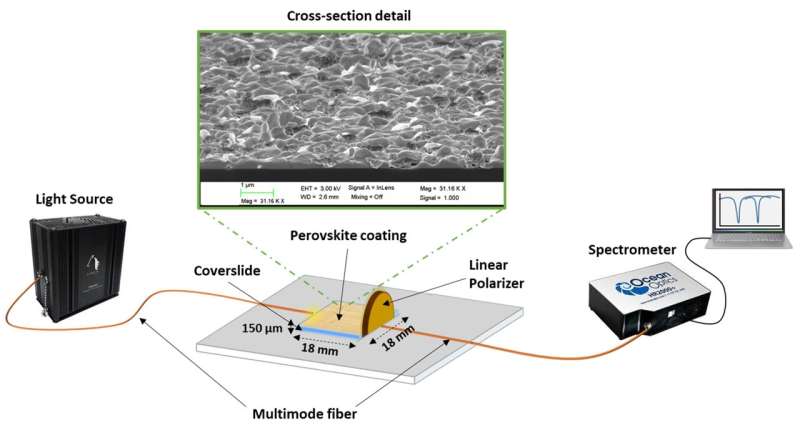This article has been reviewed according to Science X's editorial process and policies. Editors have highlighted the following attributes while ensuring the content's credibility:
fact-checked
proofread
Generation of lossy mode resonances using perovskite nanofilms

In recent research, scientists have unlocked the potential of a remarkable material called perovskite to revolutionize the world of optical sensing. Their study is published in the journal Opto-Electronic Advances.
Imagine a world where sensors can detect subtle changes in the environment, providing us with real-time information about the air we breathe, the liquids we encounter, and the conditions around us. This is the vision that this research seeks to realize, and it does so by harnessing the power of a remarkable material called perovskite for sensing changes in the refractive index of the surrounding environment
Perovskite, a material with extraordinary optical and electrical properties, has long been used in various technologies, from LED lights to solar cells. But in this study, scientists have taken it a step further by using perovskite to create lossy mode resonance (LMR) devices. These devices act like super-sensitive detectors that can pick up even the slightest changes in their environment.
The key to making LMR devices work is choosing the right material for a thin film. Perovskite, as it turns out, fits the bill perfectly. It has unique properties that allow it to generate LMRs, which are like 'sweet spots' where the material interacts with light in a special way. These sweet spots can be fine-tuned by adjusting the thickness of the perovskite film, among other parameters.
Picture a toast with a perovskite coating: the down layer is glass or silicon. When light passes through this "toast," something magical happens. The perovskite layer interacts with the light, creating these LMRs. The researchers found that by changing the thickness of the perovskite layer, they could create different LMRs at various wavelengths of light.
These LMR devices can sense a wide range of parameters. They can let us know if the air is humid or dry, or if there are specific chemicals in the environment. They can even detect changes in temperature, pressure, or the composition of a liquid. The possibilities are endless. Think about how this could be used in everyday life.
Imagine having a tiny LMR sensor in your smartphone that can tell you if the air quality is safe or if there are harmful gases nearby. It could help monitor pollution levels or even detect leaks in industrial settings. These sensors could be placed in factories, homes, or even wearables to provide real-time information about our environment.
What is remarkable is that the researchers have not only discovered the potential of perovskite for LMR devices but also have demonstrated it experimentally. They made these devices and tested them, and the results matched their theoretical predictions. This is a significant step forward in the world of optical sensing.
In conclusion, this research opens up new possibilities for creating highly sensitive and versatile sensors using perovskite. It is like giving our technology a superpower—the ability to detect and respond to changes in the environment with incredible precision. Whether it is for safeguarding the environment, improving industrial processes, or enhancing our daily lives, perovskite-based LMR devices have the potential to make a profound impact.
The authors of this article have experimentally proposed, for the first time, the lossy mode resonance (LMR) devices based on perovskite coatings. The research conducted in this study holds significant importance within the broader landscape of scientific and technological advancements. It represents a step forward in the field of optical sensing, a domain that has the potential to impact various aspects of our lives, from environmental monitoring to industrial processes and even personal health.
Perovskite is a versatile material known for its exceptional optical and electrical characteristics. Scientists have long been captivated by its potential, and it is already used in other technologies. However, this study takes perovskite's capabilities to new heights by employing it in the creation of what are known as "lossy mode resonance" (LMR) devices.
LMR devices might sound complex, but at their core, they are super-sensitive refractometers. The secret to making LMR devices work is selecting the right material for a thin film, and perovskite is an excellent candidate. When light interacts with the perovskite layer, it generates some optical resonances (LMRs)—special points where the material and light interact in a unique way. The beauty of this lies in its versatility; by adjusting the thickness of the perovskite layer, scientists can create different number of resonances at various wavelengths of light.
In this work it has not been used to sense any specific parameter, but only to theoretically and experimentally demonstrate its existence. Therefore, different sensors can now be designed, either by depositing another additional layer sensitive to any parameter of interest, or by using the innate sensor properties of perovskites. In the same way, filters, modulators, etc. can be manufactured. This adaptability opens up a world of applications.
The experimental results align with their predictions, confirming the feasibility of perovskite-based LMR devices. Thus, the generation and emergence of multiple LMRs with varying thicknesses is unique as well as the possibility of working with both polarities, TM and TE. This is a substantial leap forward in the realm of optical sensing.
In summary, this research is a beacon of progress in the quest for advanced optical sensors. This study highlights the potential of perovskite thin films for the development of novel LMR-based devices that can be used for environmental monitoring, industrial sensing, and gas detection, among other multiple applications.
More information: Dayron Armas et al, Generation of Lossy mode resonances (LMR) using perovskite nanofilms, Opto-Electronic Advances (2023). DOI: 10.29026/oea.2024.230072
Provided by Compuscript Ltd





















